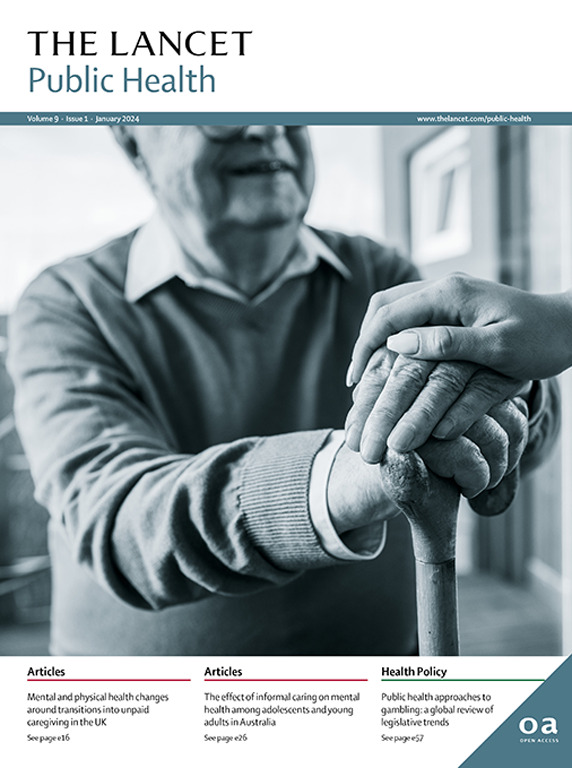估算2000年至2019年全球神经和心理健康直接卫生保健支出:一项建模研究
IF 25.4
1区 医学
Q1 PUBLIC, ENVIRONMENTAL & OCCUPATIONAL HEALTH
引用次数: 0
摘要
在全球范围内,包括神经和精神健康状况在内的脑部疾病负担正在上升。尽管负担不断增加,但量化全球脑疾病护理服务支出模式的文献很少。我们的目标是量化2000年至2019年期间与脑部疾病相关的医疗保健直接支出。在这项建模研究中,我们估计了2000年至2019年期间204个国家18个年龄组的男性和女性的24种脑部疾病的直接支出。我们使用《全球疾病、损伤和风险因素负担研究(GBD) 2023》中的疾病患病率和发病率、卫生计量与评估研究所疾病支出项目的相对护理价格估算,以及国民卫生账户中特定护理类型和特定国家调整因素,对脑部疾病的直接卫生支出进行估算。我们使用层次线性混合效应模型回归调整了我们的估计。我们估计,2019年脑部疾病的直接医疗支出为1.7万亿美元(95%不确定区间为1.6 - 1.9),自2000年以来,这方面的支出每年增长3.5%(3.2 - 3.7)。2019年,用于神经系统疾病服务的直接支出占总支出的51.8%(48.4% - 55.6%),其中住院护理服务占全球大脑健康总支出的最大比例。50-74岁的老年人在护理服务上的支出最高,增长最快。总体而言,性别差异很小。对大脑健康的直接支出对社会造成了巨大的经济负担。鉴于全球人口日益老龄化,至关重要的是,政策制定者应优先考虑支持受脑部疾病影响的家庭的干预措施。为罗氏控股和基因泰克提供资金。本文章由计算机程序翻译,如有差异,请以英文原文为准。
Estimating global direct health-care spending on neurological and mental health between 2000 and 2019: a modelling study
Background
The burden of brain disorders, including neurological and mental health conditions, is rising globally. Despite the increasing burden, literature quantifying global spending patterns on care services for brain disorders is sparse. Our aim was to quantify the direct spending on health care associated with brain disorders between 2000 and 2019.Methods
In this modelling study, we estimated direct spending for 24 brain disorders across 204 countries in males and females across 18 age groups between 2000 and 2019. We used disease prevalence and incidence from the Global Burden of Diseases, Injuries, and Risk Factors Study (GBD) 2023, relative price of care estimates from the Institute for Health Metrics and Evaluation Disease Expenditure Project, and type of care-specific and country-specific adjustment factors from the National Health Accounts, to develop estimates of direct health spending on brain disorders. We adjusted our estimates using a hierarchical linear mixed-effects model regression.Findings
We estimated US$1·7 trillion (95% uncertainty interval 1·6–1·9) in direct health-care spending on brain disorders in 2019, in which spending grew annually at 3·5% (3·2–3·7) since 2000. Direct spending on services for neurological disorders accounted for 51·8% (48·4–55·6) of total spending in 2019, in which inpatient care services represented the largest fraction of overall spending on brain health globally. Older adults aged 50–74 years had the highest spending on care services and the steepest growth. There were minimal sex differences overall.Interpretation
Direct spending on brain health contributes to a substantial economic burden for societies. In light of an increasingly ageing global population, it is crucial that policy makers prioritise interventions that support households affected by brain disorders.Funding
Roche Holdings and Genentech.求助全文
通过发布文献求助,成功后即可免费获取论文全文。
去求助
来源期刊

Lancet Public Health
Medicine-Public Health, Environmental and Occupational Health
CiteScore
55.60
自引率
0.80%
发文量
305
审稿时长
8 weeks
期刊介绍:
The Lancet Public Health is committed to tackling the most pressing issues across all aspects of public health. We have a strong commitment to using science to improve health equity and social justice. In line with the values and vision of The Lancet, we take a broad and inclusive approach to public health and are interested in interdisciplinary research.
We publish a range of content types that can advance public health policies and outcomes. These include Articles, Review, Comment, and Correspondence. Learn more about the types of papers we publish.
 求助内容:
求助内容: 应助结果提醒方式:
应助结果提醒方式:


